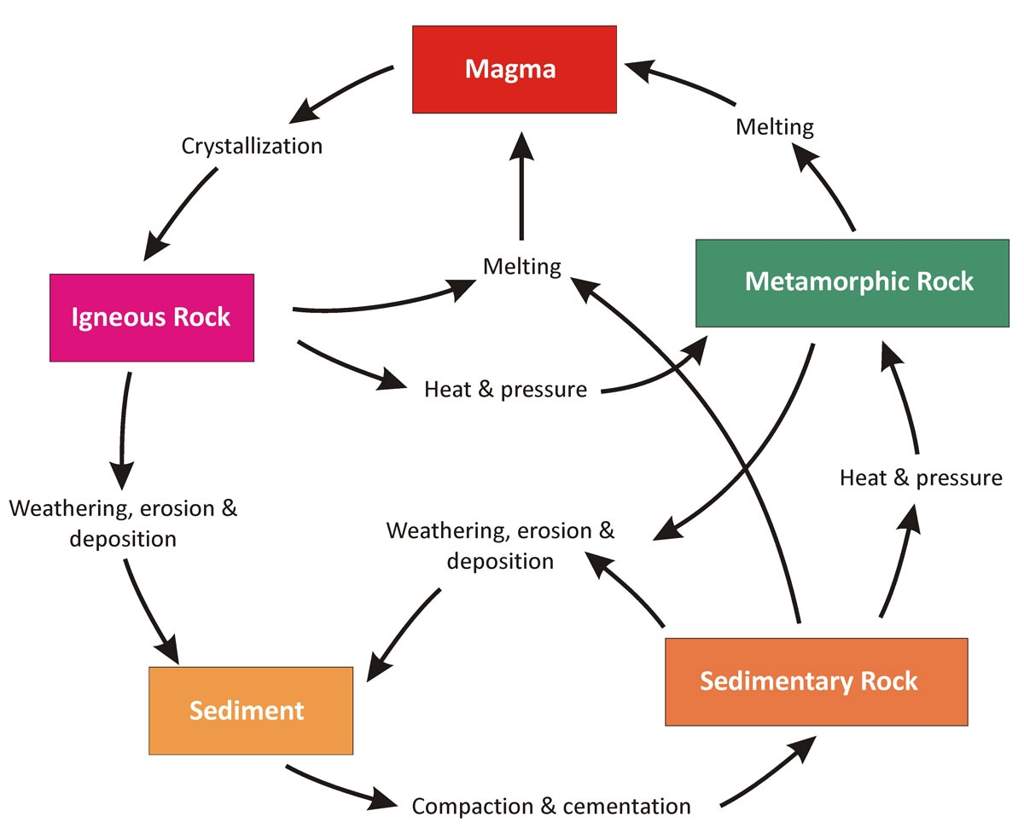The Rock Cycle Review - Weekly Blog (9/10-9/16)
 |
| The rock cycle by Tasman Walker |
Summary
Geology is the study of rocks. In other words, it is the study of the structure of the planet, and the various forces that make and make and shape the earth. The three main types of rocks are igneous rocks, sedimentary rocks, and metamorphic rocks. These rocks are classified by how they look, and how they are formed. There are five transformations that can affect a rock. These include heat & pressure, melting, cooling, weathering & erosion, and compacting & cementing. Whenever a transformation takes place, a rock will change from one form to another, traveling through the rock cycle!
The first type of rock is a sedimentary rock. Sedimentary rocks are formed from particles of sand, pebbles, shells, and sediments. The sediments gradually create layers and eventually harden into rock. They are made of sediments that have been deposited and then pressed together. Sedimentary rocks are pretty soft and may break apart easily. There are sediments visible in the rock, and this is the only rock that contains fossils. Some examples of sedimentary rocks are conglomerate and limestone.
Igneous rocks are formed when molten material from beneath the Earth's surface cools and hardens. The magma cools either inside of the Earth (Intrusive,) or erupts from volcanoes in the form of lava (extrusive.) The magma cools very quickly and no crystals will form. This leaves the rock looking shiny and glass-like. Occasionally, when igneous rocks are cooling, gas bubbles get trapped in the rock which leaves tiny holes and spaces in the rock. Some examples of igneous rocks are basalt and obsidian.
Igneous rocks are formed when molten material from beneath the Earth's surface cools and hardens. The magma cools either inside of the Earth (Intrusive,) or erupts from volcanoes in the form of lava (extrusive.) The magma cools very quickly and no crystals will form. This leaves the rock looking shiny and glass-like. Occasionally, when igneous rocks are cooling, gas bubbles get trapped in the rock which leaves tiny holes and spaces in the rock. Some examples of igneous rocks are basalt and obsidian.
Metamorphic rocks are formed under the surface of the earth when an existing rock is changed (metamorphosis) by heat, pressure, or chemical reactions. Metamorphic rocks have ribbon-like layers or shiny crystals from minerals slowly growing over time on their surface of the rock. Some examples of metamorphic rocks include gneiss and marble.
SP3: Planning and Carrying Out Investigations
In class, we conducted an investigation to show how various rocks change form during the rock cycle. We demonstrated how rocks are formed due to weathering & erosion, heat & pressure, compacting & cementing, melting, and cooling. Questions that I identified include 'what various factors affect how various rocks are formed?', and 'what are some differences between each type of rock?' This investigation has helped us see how various rocks are transformed throughout the rock cycle and visually understand how the rock cycle works.
XCC: Cause and Effect
This week, I observed a cause and effect relationship between a transformation, and how this effects the new rock that it creates, For example, the cause of heat and pressure may lead to the effect of metamorphic rocks being formed. This cause and effect relationship also happens with igneous and sedimentary rocks. When magma cools, (cause,) it leads to the creation of igneous rocks (effect.) We tested this relationship in class by adding various transformations to a starburst and see what the outcome, or rock, would be. Noticing this relationship has helped me learn more about the rock cycle and how various transformations can affect a rock.
Comments
Post a Comment